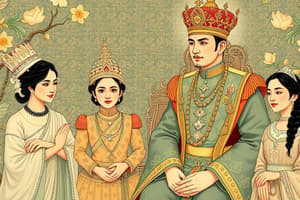Podcast
Questions and Answers
What was the duration of King Rama V's priesthood?
What was the duration of King Rama V's priesthood?
- One year
- One month
- Six months
- Fifteen days (correct)
What was the old tradition of rightful succession to the throne before King Rama V's reforms?
What was the old tradition of rightful succession to the throne before King Rama V's reforms?
- The king's cousin would inherit the throne
- The king's eldest son would inherit the throne
- The king's brother would inherit the throne
- The king would appoint a second in command known as Krom Phrarajwangborvorn (correct)
What was the significance of the Ratanakosin Sok era introduced by King Rama V?
What was the significance of the Ratanakosin Sok era introduced by King Rama V?
- It was influenced by French culture
- It was influenced by Burmese culture
- It was based on the solar system (correct)
- It marked the beginning of the Chakri Dynasty
Who was the first Crown Prince of the Chakri Dynasty?
Who was the first Crown Prince of the Chakri Dynasty?
What was the previous new year day in Thailand before King Rama V's reforms?
What was the previous new year day in Thailand before King Rama V's reforms?
What was the primary reason behind King Rama V's decision to reform the administrative system in Thailand?
What was the primary reason behind King Rama V's decision to reform the administrative system in Thailand?
Which of the following is NOT a role assigned to the Council of State in King Rama V's reformed administrative system?
Which of the following is NOT a role assigned to the Council of State in King Rama V's reformed administrative system?
How did the administrative reform under King Rama V affect the organization of the country's regional structure?
How did the administrative reform under King Rama V affect the organization of the country's regional structure?
What was the significance of the establishment of the Ministry of Interior in 1892?
What was the significance of the establishment of the Ministry of Interior in 1892?
Based on the information provided, what can be inferred about King Rama V's approach to reforming the administrative system in Thailand?
Based on the information provided, what can be inferred about King Rama V's approach to reforming the administrative system in Thailand?
Flashcards are hidden until you start studying
Study Notes
King Rama V's Reforms
- In 1873, at the age of 20, King Rama V entered the priesthood for 15 days, becoming the first King of the Chakri Dynasty to be ordained as a Buddhist monk while on the throne.
- After his resignation from the priesthood, he had his second coronation on November 16, 1873, and took over the government.
Abolition of Traditions
- The King abolished the tradition of bowing down and lying face down before the king, allowing people to sit or stand before him during audiences.
Succession to the Throne
- The King changed the tradition of rightful succession to the throne, introducing the position of Crown Prince (Makut Rajkumal) in 1886, with Prince Vachirunhit as the first Crown Prince of the Chakri Dynasty.
Calendar Reform
- The King switched the calendar from Chula Sakarat to Ratanakosin Sok (Rattanakosin Era) in 1888, which began in 1782 and is based on the solar system.
- The new year day was designated as April 1st, starting from April 1st, 1889.
Mourning Tradition
- The King changed the tradition of shaving heads to mourn the king's death, instead asking everyone to wear black clothes.
Public Administration
- The King created two councils to improve the system in Thailand: the Council of State and the Privy Council.
- The Council of State advises the King on state matters, with members comprising Ministers and at least 12 persons nominated by the King.
- The Privy Council serves as the King's private advisors, with members chosen by the King, aiming to improve the well-being of the people.
Government Reforms
- The King made changes to the old government system, setting up government departments and later upgrading them to ministries.
- There were 10 ministries established, including the Ministry of Interior, Ministry of Defence, and Ministry of Foreign Affairs, among others.
- In 1892, the Ministry of Interior was established to oversee regional and local areas, with Prince Damrong leading the reorganization of the administrative system.
- The country was divided into 18 'Monthons' or main divisions, each consisting of a group of provinces, and further divided into districts, sub-districts, and villages.
Studying That Suits You
Use AI to generate personalized quizzes and flashcards to suit your learning preferences.




